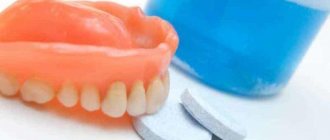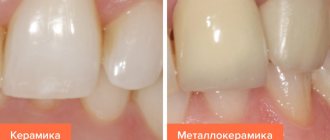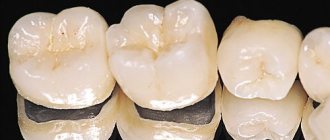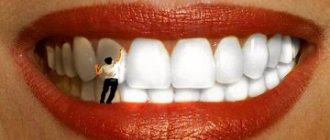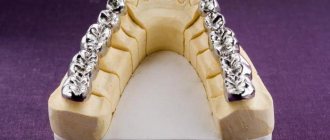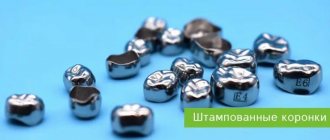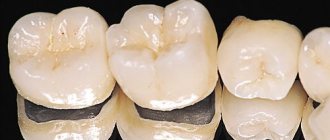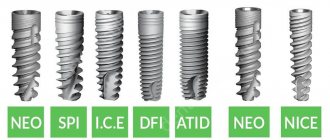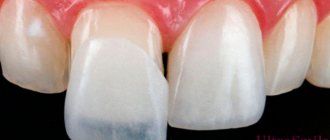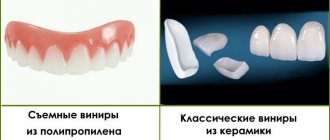April 2, 2019
Today, dentists offer their patients an acetal prosthesis as one of the methods for restoring teeth. However, patients have little objective information about this type of construction, which is why many choose those prostheses that have long been heard of - clasp, nylon or acrylic. So that you have an alternative, the editors of the UltraSmile.ru portal offer to analyze in detail information about the advantages of these products. Also at the end of the article you can find information about the disadvantages of acetal devices.
What kind of prosthesis is this and what features does it have?
An acetal denture is a partial removable [1] orthopedic structure made of synthetic resin (polyacetal). It is light and durable, allowing you to make comfortable dentures for installation on the upper or lower jaw with partial absence of teeth. Acetal is most often used to make crowns, hooks or clasps (fixing components), frames or arches, and less commonly - core inlays, gum formers for installation on implants. Removable acetal ones are attached to the supporting teeth using clasps.
%akc61%
Acetal removable dentures are distinguished from others by the shade of the clasps, frame (arch), and palatal bridge on the upper jaw. If, for example, clasp ones are gray metallic, and acrylic and nylon ones are translucent pink, then acetal ones are white or milky matte, not transparent.
What material is used
Acetal (more precisely, polyacetal, polyformaldehyde, polyoxymethylene) is an organic thermoplastic compound discovered about 100 years ago. The material is initially crystalline and has a white, or rather milky color, and is opaque. Some manufacturers color the material according to the Vita scale in 15-17 shades for artificial teeth and pink shades for gums. The material is supplied marked: “Acetal plastic” or “monomer-free acetate plastic”. Quality brands – Evihard, Nuxen, Pressing Dental Srl
Acetal is hydrophobic, i.e. does not absorb oral fluid, saliva, or water at all. It is resistant to alkalis, but can be destroyed in an acidic environment, so you should be careful when consuming acidic foods and drinks.
In terms of strength, polyacetal can be compared with a cobalt-chromium alloy - they have approximately equal characteristics in terms of distribution of chewing load, resistance to abrasion and deformation during long-term use. The material melts at a temperature of 180 degrees Celsius, i.e. You can safely consume hot food and drinks. The absence of toxic acrylic monomer in the composition greatly reduces the risk of an allergic reaction.
Indications and contraindications
Indications for the installation of acetal prostheses are the following cases:
- the need to restore 1-2 or more teeth: for good fixation and load distribution, at least 6-7 teeth must be preserved in the row,
- the remaining teeth exhibit mobility of the 1st degree,
- increased abrasion of enamel,
- included and end defects: in the first case, teeth are preserved along the edges of the “gap” (where there is no tooth), in the second case there are no teeth at the edge of the row,
- inflammation of the gums: gingivitis, periodontitis,
- inconvenience in wearing other orthopedic structures: for example, if acrylic ones cause discomfort due to their massiveness, and clasp ones provoke galvanosis (the appearance of an electrical impulse between dissimilar metals),
- allergies to other synthetic materials and metals,
- the need for temporary prosthetics before implantation, if it is not yet possible to install implants.
Contraindications are such clinical cases as:
- complete or almost complete edentia (absence of teeth),
- pronounced mobility of the remaining supporting teeth,
- severe atrophy of the alveolar ridge (loss of bone and gums),
- allergic reaction to the material or increased sensitivity of the gums,
- small sizes of supporting crowns: hook-clasps will not be able to attach well to them, they will fly off or overload this area.
Average prices
The cost directly depends on the status of the dental clinic that will manufacture and install the acetal product. The final cost includes the services of a dental technician, preparatory manipulations and the actual installation of the structure.
The average price in Moscow varies between 25,000 – 27,000 rubles. Depending on the characteristics of each individual case, size, volume of materials spent, complexity and duration of the process, the cost may vary, either down or up.
Types of orthopedic structures
The classification identifies several options for acetal dentures. Depending on the location of installation, it can be on the lower or upper jaw. In length – an immediate prosthesis (“butterfly”) for 1-2 teeth and an extended orthopedic structure that restores multiple and/or scattered defects in a row. As a rule, the last option is most often used, because The material is too hard for a butterfly.
As for popular varieties, they can be as follows:
- prosthesis with acetal clasps,
- clasp acetal dentures for the upper and lower jaws.
Clasp prosthesis made of acetal (without metal)
Such a device can be called a complete analogue of the clasp one. Only in acetal, the arch or frame is made of white acetal - there is no metal at all in this orthopedic design. Pink gum is built up on top of the arch; it can also be made of acetal or more transparent and elastic acrylic. Hooks or clasps are also made of acetal. Artificial teeth can be made from the same material, or they can be made from more pliable plastics. For attachment to the upper jaw there is an acetal palatal bridge. According to patient reviews, acetal dentures are lighter than classic clasp dentures with hooks, and are fixed in the oral cavity just as reliably.
Clasp metal with acetal clasps
In a traditional clasp denture, there is a metal arch inside and metal clasps on top - they grip the supporting teeth like small processes or “claws”. But when you smile, gray clasps can be noticeable. Therefore, it is allowed to make hooks from acetal, but leave the arc metal.
Read more about all possible prosthetic options for partial absence of teeth on one or two jaws.
Comments
Which dentures are better: acetal, nylon or metal clasp? I’ve read different reviews on this topic, but I still can’t decide which prostheses I need.
Ulyana Vladimirovna (04/20/2019 at 07:22 pm) Reply to comment
- Dear Ulyana Vladimirovna! It is believed that acetal dentures are better than nylon ones, because Despite their similar flexibility, they are stronger and stiffer, holding better in the mouth. Also, acetal structures are cheaper than nylon ones, because the price of a material such as acetal is lower. As for the comparison of acetal and metal clasp devices, here you need to focus on the indications and personal preferences. Metal systems are more durable and stable, but they can cause long-term addiction and allergies, changes in taste in especially sensitive patients, but with acetal structures this probability is minimized. However, if periodontitis or periodontal disease is present, metal systems will be more preferable.
Editorial staff of the portal UltraSmile.ru (04/24/2019 at 09:17) Reply to comment
Write your comment Cancel reply
Advantages and disadvantages
If we consider the pros and cons of acetal dentures, then they provide more benefits for patients - in comparison with conventional acrylic or even reliable clasp structures. The advantages of acetal products are as follows:
- good fixation on the teeth and uniform distribution of the chewing load (in comparison with acrylic ones): this is facilitated by fairly rigid acetal clasps and frame,
- ease of design and its installation in the oral cavity,
- good aesthetics: white clasps are not as noticeable on the teeth as gray metal ones,
- quick adaptation: the acetal removable denture on the upper jaw has only a thin bridge, and on the lower jaw there is a small imitation of gum, so it does not overlap the taste buds so much, distorts diction less, and does not provoke nausea,
- relatively simple care: there is no need to remove the denture every time after eating,
- acetal clasps put less pressure on crowns, so the enamel does not wear off as much as with metal hooks,
- flexibility and lower risk of breakage: the acetal frame can be bent 90 degrees, and it will not break or bend - it will return to its original position. Patients note that if they fall from a height (with careless handling), the prosthesis may not crack/break,
- you can get dentures for periodontal diseases, for loose teeth (but not in severe cases),
- low risk of allergies,
- low cost.
Disadvantages include factors such as:
- rigidity of the orthopedic structure: can provoke increased atrophy of bone tissue, loosening of teeth due to periodontitis (if the patient places or removes it incorrectly),
- as atrophy progresses, chafing on the gums, pain, stomatitis,
- when worn for a long time, you have to glue the prosthetic base onto a fixing cream (“Koregu” or “Protefix”),
- chewing with removable dentures is not very comfortable: only 6 out of 10 people say that they are relatively comfortable using removable devices,
- opacity of the material: therefore, the aesthetics here are lower than, for example, nylon,
- over time, the material absorbs dyes from food, becomes colored by tobacco smoke, darkens from plaque,
- there is a risk of breakage of individual clasps.
How is production and installation carried out?
First, the patient undergoes diagnostics (examination, x-rays), sanitation of the oral cavity (removal of diseased and damaged teeth). After that, impressions are taken from the dentition, and an individual impression tray is made. Next, impressions are made again, a working model is made, and the future orthopedic product is cast and pressed on it.
The manufacturing technology of an acetal prosthesis is quite complex, and such a design is created only in a dental laboratory with modern equipment. Since acetal granules begin to melt at a temperature of 180 degrees Celsius, a thermal injection press will be required to make the prosthesis.
Then the finished structure or arch with clasps is cooled and tried on a model or directly to the patient. Next, gums are added to the frame, crowns are placed, the product is polished and sent for final fitting. If there are no shortcomings, it is installed for the patient.
Adaptation period
An important stage of wearing is adaptation; it is necessary to take into account a number of factors that may interfere with comfortable implantation. Patients often perceive normal manifestations and reactions of the body as such.
There are three stages of addiction:
- irritation;
— partial braking;
- full braking.
First
– observed almost immediately after installation. In this case, the structure is perceived as something foreign, diction disturbances, hypersalivation are noticeable, and the gag reflex may worsen. The second stage lasts up to five days, during which time all aggravated negative feelings return to normal, the gag reflex ceases to bother you, and salivation decreases to a natural level. The last stage lasts until the 33rd day maximum, during which time all aspects return to normal, discomfort completely disappears and the structure begins to be perceived as an integral attribute that does not cause inconvenience.
The situation is easiest for patients who have already worn the same or similar designs. In this case, the system takes root completely on the 7th day and all body reactions are much less pronounced during this period.
It is necessary to follow the rules of care so that the structure serves for a long time without problems. When removing, soaking in a disinfectant solution is required, and cleaning the oral cavity proceeds as usual.
Service life and care
The service life of a removable acetal prosthesis is 3-5 years. With good care it can be extended a little. To do this, you need to regularly remove the structure from your mouth for cleaning and disinfection (once every 1-2 weeks), because without proper cleaning, the surface will quickly darken. In addition, you need to brush your teeth twice a day - your own and artificial ones, using a special brush and toothpaste. To prevent breakage and displacement during the act of chewing, you should avoid hard and stretchy foods. Do not chew candy or nut shells, avoid toffees and toffees, and do not open jars with your teeth. You should also regularly visit an orthopedic dentist for examination and correction of the prosthesis, minor repairs and cleaning if necessary.
Frequently asked questions to the doctor
Getting used to dentures
How to get used to dentures as quickly as possible?
The issue of addiction is acute for many people. After all, without a strong habit you are unlikely to experience comfort. To avoid pain, it is recommended to perform a light massage. It is done with a toothbrush or your finger.
At first, it is not recommended to eat solid foods. If you experience dry mouth, drink as much fluid as possible.
Alternatives to acetal prosthesis
An alternative among removable ones can be any partial removable one - acrylic, nylon, Acry-free. But the clasp and Quattro Ti (“Quadrotti”) are considered the closest, since they, along with acetal, have compact sizes and a thin palatal bridge for fixation on the upper jaw.
But these are all removable options that do not stop, and sometimes even worsen, the atrophy of the jaw bone tissue - experts recommend them only for temporary wearing. Therefore, the best way to permanently restore lost teeth is implantation. Here the orthopedic structures are attached most reliably, there is no need to remove them, and they are very easy to care for. Plus, bone atrophy stops, because the implant, as an analogue of the root, correctly transfers the load to the bone tissue.
“A former classmate once recommended a good dentist, who installed implants for my crowns. About prosthetics they said that only in six months. But without teeth you can’t walk, you can’t smile, you can’t talk. So the doctor chose a good acetal prosthesis for me. For a while. As long as I wear it normally, I haven’t noticed any problems. But, of course, I already want to get the crowns installed as soon as possible. There is no need to remove them to clean them.”
Sergey_76, review from irecommend.ru
Stock
-17%
Quadrotti dentures (without palate) 60,000 rub.
50,000 rub.
get -13 %
Metal-free dental crown made of zirconium dioxide 40,000 rub.
35,000 rub.
get -9 %
BASAL COMPLEX - Restoration of teeth on 1 jaw in 3 days 330,000 rub.
300,000 rub.
get -20 %
Osstem implant + zirconium dioxide crown 100,000 rub.
80,000 rub. get

